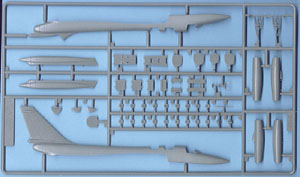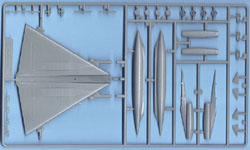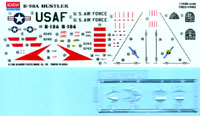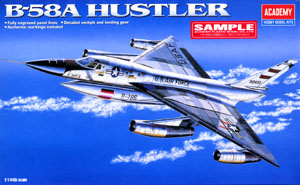Academy's 1/144 B-58A Hustler | | History The B-58 Hustler was a high-performance sports car of a bomber, but even Mach 2 performance can't beat the speed of technology. The year the B-58 entered service, 1960, saw another milestone in US aviation and a major change in strategy. While flying a U-2 at high altitude, Francis Gary Powers was shot down over the Soviet Union. While the U-2 flew much slower than a Mach 2 bomber, that incident clearly showed that high-altitude penetration attacks would be too costly, forcing SAC to adopt a low-altitude penetration mission plan. The B-52 was able to adapt to the new mission profile, but the B-58 with its high speed and high fuel consumption could not reach the Soviet Union at low altitude, even with air-to-air refueling. Thus in one swoop the brand new B-58 became obsolete. The plane still managed a decade of service, though, and made an excellent aircraft to show the flag around the world. Its four J79 engines announced its presence with an unforgettable impact, while its broad delta wing and narrow fuselage left an indelible image in the minds of aviation aficionados everywhere.  The Kit The Kit
The B-58 has been a fairly popular modeling subject over the years, with several box-scale kits being produced during the 1960s. It wasn't until the 1980s that a standard scale kit came out, though, and during that decade the Hustler seemed to enjoy a resurrection in the modeling community, with both 1/72 and 1/48 kits being produced. It wasn't until recently, though, that a 1/144 kit was released. This Academy kit is actually a rebox of the Hobbycraft kit (which most likely was originally tooled by Academy). The kit is one of the best 1/144 kits I've seen lately. The engineering of the parts is probably the best solution for a model of such a complex shape, with a one-piece wing & two-piece fuselage. Recessed panel lines are used throughout, and while they're a touch heavy for 1/144, once you've primered the plane in preparation for the natural metal finish, they should look just right. What's really interesting about this kit is that it comes with a complete interior for all three crew stations. The front office has an instrument panel (with a decal for the instruments), a rear bulkhead, and an ejection seat, all fitting onto a floor that also makes up the nose gear well. No control stick is provided, but there is sidewall detail. The rear two cockpits share a floor, with bulkheads & instrument panels splitting the two sections off. The seats are the same as the one up in front. Like the pilot's station, the rear two stations also have sidewall detailing. While you may think that none of this will be visible when the model is finished, the kit has the hatches separate, letting you pose them in the open position. The only other thing you'll want to add to the insides of the fuselage is some weight in the nose (the instructions suggest 2-3 grams).  The one-piece wing will need some cleanup on the leading edge, but the way it fits into the fuselage should greatly limit the amount of filler needed. In fact, with some careful dry fitting beforehand you could probably get away with no filler at all. The rear fuselage has a choice of either the gun or a straight point, leaving the engines as the last main assembly. These are molded in right and left halves, with one half incorporating the pylon. Each engine has a separate nose piece and exhaust petals. With some careful dry fitting you could finish the exhaust petals separately, resulting in a nice, sharp demarcation without the bother of masking. The pylons will need some work to fair in smoothly, but you could still avoid any filler here. The one-piece wing will need some cleanup on the leading edge, but the way it fits into the fuselage should greatly limit the amount of filler needed. In fact, with some careful dry fitting beforehand you could probably get away with no filler at all. The rear fuselage has a choice of either the gun or a straight point, leaving the engines as the last main assembly. These are molded in right and left halves, with one half incorporating the pylon. Each engine has a separate nose piece and exhaust petals. With some careful dry fitting you could finish the exhaust petals separately, resulting in a nice, sharp demarcation without the bother of masking. The pylons will need some work to fair in smoothly, but you could still avoid any filler here.
The other underside bits and pieces include some very nicely detailed landing gear struts and two choices of pods. The kit includes the small pod and the large pod, but you don't get the combo one. In my mind the Hustler just doesn't look like a Hustler without the large pod, but it is a nice touch to include the smaller one as well. In fact, with some modifications, I think you could combine the small one with the large one to get the combo unit.  The decals offer a pair of Hustlers to choose from, one from the 43rd BW and one from the 6592nd TS. Like all B-58s, both of these examples are natural metal overall, with a black radome & antiglare panel. The differences are in the details, with the 43rd BW plane having the standard SAC sash on the nose and red stripes on the tail. These red stripes are also present on the pod, along with a number 'B-186'. The final individual marking is the name 'The Firefly' on the nose. Two choices are provided for the name, one in red and one in black. The 6592nd TS plane is somewhat plainer in appearance, wtih no SAC sash and just a red chevron on the tail. A fairly good selection of stencilling is included, which when combined with a nice multi-colored NMF finish should really make your Hustler look great no matter which option you choose. The decals offer a pair of Hustlers to choose from, one from the 43rd BW and one from the 6592nd TS. Like all B-58s, both of these examples are natural metal overall, with a black radome & antiglare panel. The differences are in the details, with the 43rd BW plane having the standard SAC sash on the nose and red stripes on the tail. These red stripes are also present on the pod, along with a number 'B-186'. The final individual marking is the name 'The Firefly' on the nose. Two choices are provided for the name, one in red and one in black. The 6592nd TS plane is somewhat plainer in appearance, wtih no SAC sash and just a red chevron on the tail. A fairly good selection of stencilling is included, which when combined with a nice multi-colored NMF finish should really make your Hustler look great no matter which option you choose.
Conclusion The B-58 isn't a small plane and if you want to build more than one, 1/144 is an ideal scale to build them in. Thankfully the Academy kit is an excellent little kit and the simple construction will ensure that your only difficulties will be with getting the multi-colored NMF scheme done flawlessly. If you're wanting to build some Hustlers, definitely get a couple of these. References 'Decade of a Delta', Paul Jackson, Air Enthusiast Thirty-Four, 1987 Our thanks to MRC for the review sample. |


 




|
